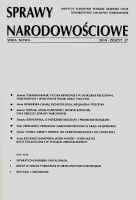Figura krwiopijcy w dyskursie religijnym, narodowym i lewicowym Polski roku 1945/1946. Studium z antropologii historycznej.
The figure of the bloodsucker in polish religious, national and left-wing discourse, 1945/1946: a historical anthropology study
Author(s): Joanna Tokarska-BakirSubject(s): Cultural Essay, Political Essay, Societal Essay
Published by: Instytut Slawistyki Polskiej Akademii Nauk
Keywords: blood-libel legend; Jews in Poland; aftermath of the Holocaust in Poland; anti-Semitism
Summary/Abstract: Despite the fact that after 1945 all anti-Jewish pogroms in Poland (except one) were given a blood label—a rumor about Jewish murderers of Polish children—this fact has not attracted the attention of historians until recently. Conspiracy theories, however, were a lot more popular and noted that the pogroms had been provoked by “Soviet advisers” or “syonists.” The author of this essay argues that participants of anti-Semitic violence, the assailants as well as policemen, prosecutors, and judges involved in controlling the events – though they represented a variety of different political approaches – were all united by a common socio-mental formation, and remained united by a figure of the Jew as bloodsucker (this mystic figure is described here according to Mary Douglas). Many of them, security and secret services functionaries included, succumbed to a suggested blood libel. Moreover, some traces of blood libel are still present in Poland, not only as folk beliefs (cf. the research conducted under the present author’s direction in Sandomierz). The essay’s aim is to present a structural background of slow growing “Polish national socialism” on the one hand and old anti-Jewish resentments on the other, as both were a ground for a specific anti-Jewish alliance in the first period after World War II. Thus, the author claims that a synthesis of religious anti-Semitism (“Jew–kidnapper–bloodsucker”), modern anti-Semitism (“Jew–capitalist– –bloodsucker”) and the “Judeo-communists” occurred in Poland, which crippled a healthy body of the nation and the communist party. The essay is based on, inter alia, letters intercepted by the censorship in 1946, the reports made by some anti-communist underground fighters, a number of memories and documents of communist secret services officers, as well as documents accumulated in the course of investigations held by the authorities after the pogroms of 1945 and 1946.
Journal: Sprawy Narodowościowe
- Issue Year: 2010
- Issue No: 37
- Page Range: 19-47
- Page Count: 29
- Language: Polish

